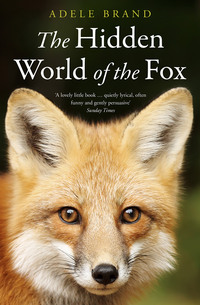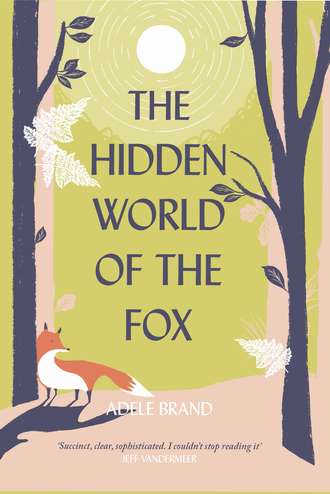
Полная версия
The Hidden World of the Fox

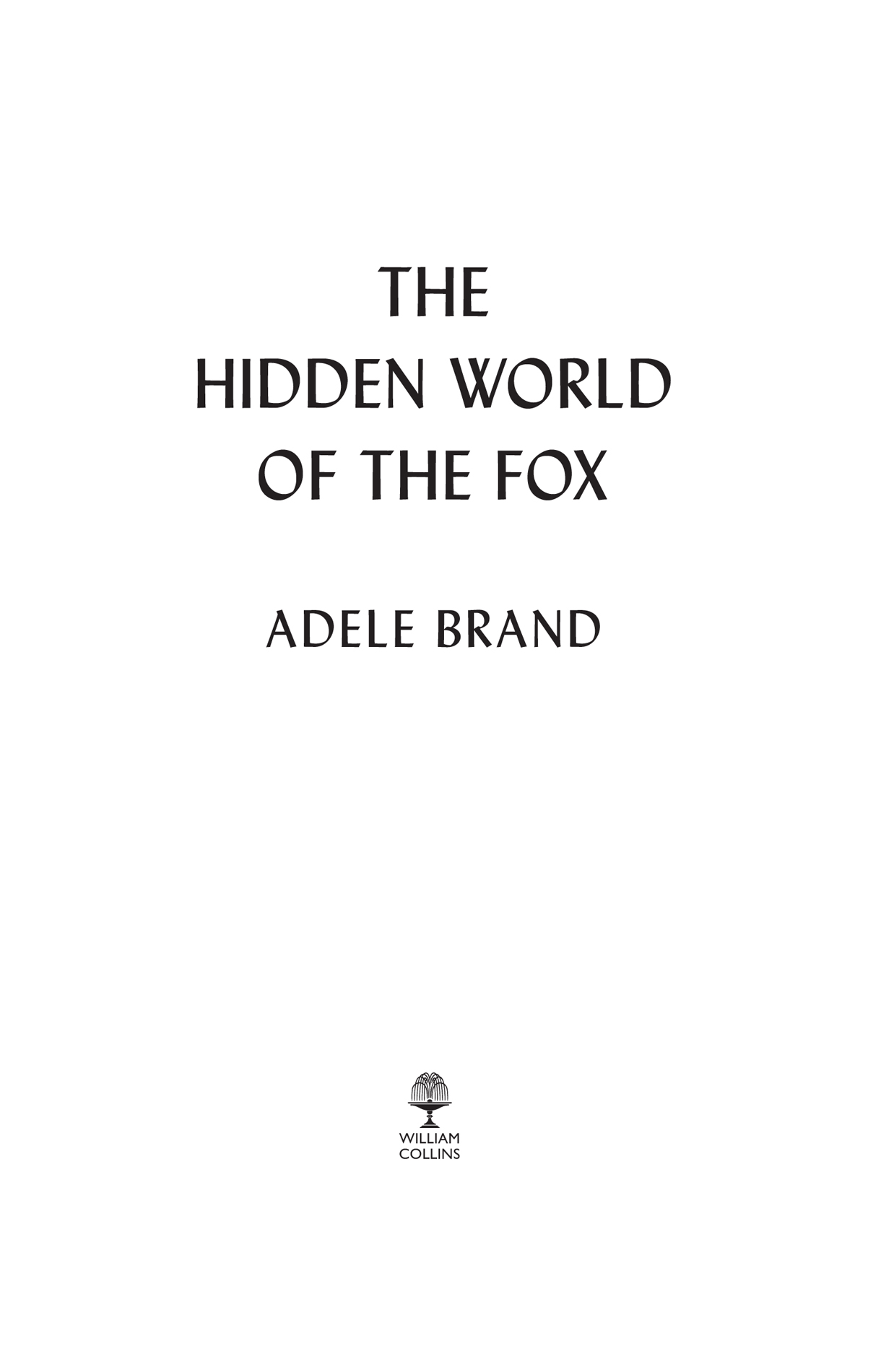
COPYRIGHT
William Collins
An imprint of HarperCollinsPublishers 1 London Bridge Street London SE1 9GF www.WilliamCollinsBooks.com
This eBook first published in Great Britain by William Collins in 2019
Copyright © Adele Brand 2019
Cover design and text artwork by Jo Walker
Adele Brand asserts the moral right to be identified as the author of this work
A catalogue record for this book is available from the British Library
All rights reserved under International and Pan-American Copyright Conventions. By payment of the required fees, you have been granted the non-exclusive, non-transferable right to access and read the text of this e-book on-screen. No part of this text may be reproduced, transmitted, down-loaded, decompiled, reverse engineered, or stored in or introduced into any information storage and retrieval system, in any form or by any means, whether electronic or mechanical, now known or hereinafter invented, without the express written permission of HarperCollins
Source ISBN: 9780008327286
Ebook Edition © October 2019 ISBN: 9780008327293
Version: 2019-09-27
For my parents

CONTENTS
Cover
Title Page
Copyright
Dedication
1 Who is the Fox?
2 A Brief History of the Fox
3 Where do Foxes Live?
4 What Does the Fox Look Like?
5 Fox Family Matters
6 The Fox and its Neighbours
7 What Does the Fox Say?
8 Counting Foxes
9 In Sickness and in Health
10 Predators Among Us
11 When the Fur Flies
12 Tornado in a Cage
Epilogue: Fame and Foxes
The Fox Watcher’s Toolkit
Acknowledgements
Bibliography
About the Author
About the Publisher

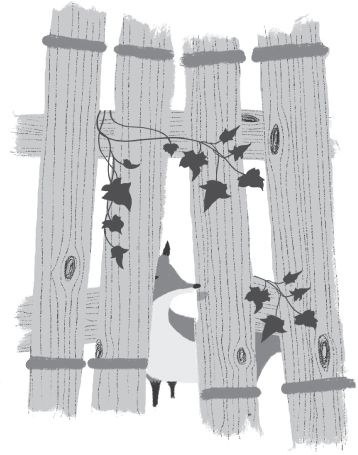
1
Who is the Fox?
VISUALISE A FOX: flame-orange on a white canvas, black paws and thick brush, pointed muzzle and diamond-sharp eyes. Now paint its native wildwood behind it – this fox is trotting through the undergrowth, exploiting trails within the brambles trampled by badgers. It leaves neat narrow tracks on mud softened by afternoon rain, and snags its fur on thorns in passing.
Woodland, farmland, hedgerows and weary old trees. Owls, hedgehogs, rutting deer. Dead man’s fingers – that is, grisly-looking black fungi – poking through sweet chestnut leaves in the autumn; woodpeckers playing rat-a-tat-tat on dying branches in the spring.
This is the classic British landscape of the classic British fox: the precious fragments of countryside saved from industrialised agriculture and overdevelopment. Ancient, intriguing, revitalising and poetic, our rural semi-wild has enchanted animal-focused authors from Beatrix Potter to Colin Dann of The Animals of Farthing Wood fame. The fox of tradition lives squarely within it, running under a cloud of mythology stirred by friend and foe alike.
But it is not the only fox of twenty-first-century Britain.
IMAGINE ANOTHER DUSK, this one after a day when chainsaws groaned and concrete mixers churned, and builders wolf-whistled at local women from a half-built rooftop. Woodland here is being transformed into a housing estate, rimmed by a newly built wall thick enough to please Hadrian, its bricks highlighted in passing by the headlights of commuter traffic.
A small vixen with a slender face and wary eyes tugs at chips dropped by the workmen, slicing artificially flavoured potatoes with enlarged molars called carnassials which define her species as a member of the Carnivora. She digs under the perimeter fence, and darts across the main road, feet fast and brush bouncing, passing me as I walk my dog. Ironic, perhaps, for wolves – the ancestor of dogs – once lived here too, feeding foxes through scraps of deer meat. The last Home Counties wolf was killed in Hampshire 800 years ago. The crowds returning from London have forgotten; perhaps the woodland has not. In an ecosystem, every extinction is like snapping a link in a chain.
But foxes themselves are in no danger of disappearing. Into a driveway the vixen turns, past trees native to China, through a side gate sealed against burglars, into a garden where another fox is burying Bakers Complete dog biscuits. The little vixen is an intruder in this territory. The resident flies at her, flipping her upside down, and skull-splitting screams – theatrical, but bloodless – pepper the night over the droning of the traffic.
She struggles free, and bolts back across the road into the fragmented woodland. Her motive for this daring if ill-fated trespass is obvious: she is lactating and needs food and water to produce milk for her cubs. She is driven by an unquenchable instinct to survive.
THAT WAS LAST YEAR’S DRAMA.
I haven’t seen that particular vixen for a few days; it is mid-March as I write this, and doubtless she is underground with a new litter. She has survived the last twelve months despite her wood being turned into houses with million-pound price tags, and despite the best efforts of the neighbouring fox group to keep her out of the garden. Her body language is tenser than theirs, her eyes a little sharper, and her habit of poking her muzzle through gaps in the fence never fails to amuse.
This is not the city; it is Surrey’s battered greenbelt. Despite the developers stalking the county like thieves eyeing up wallets, we still have rich and abundant wildlife between the golf courses, out-of-town supermarkets and ever slower M25. Yet only a few miles north of the endangered wildflowers thriving on our chalky hills, the mood changes. London town spikes our northern horizon with towers, giant wheels and an orange nocturnal haze. Somehow, once there, we consider it unremarkable that we have grown buildings taller than trees.
It is undeniably beautiful, that old city filled with lion statues. History smiles from every spire and road name, grand, grotesque or tragic. You fall into the rhythm of it: the river of people flowing from Victoria station in the mornings, the shouts of Big Issue sellers, tourists photographing themselves in St James’s Park. Cyclists speeding across pelican crossings, strangers apologising in the street when you bump into them, anti-war protesters perched on window frames with placards while weary police keep watch – it is such a human place.
Human, but full of foxes. Many thousands of them live in urban environments in Britain, from London to Edin- burgh.
We jolt at that, sometimes alarmed, sometimes happy that a being of the ancient wildwood can find a home in Britain’s sprawling capital – it feels a little out of sync, like an Elizabethan lady in ballroom dress among the revellers in All Bar One. The contrast between free wild animal and hard concrete street is vivid, irresistible, burning a place in our collective consciousness. Fed on television images that associate wildlife with wilderness, this displacement of ‘normal’ can beget either wonder or fear. Perhaps the social reserve in the British psyche leaves us puzzling over the correct etiquette. Upon seeing a fox, many people are not quite sure what to say.
So, instead, we have put the fox in the dock for questioning. We have accused it of trespassing into the human domain, of being cheeky, of spreading disease, harming pets, and even posing a significant risk to ourselves. Unperturbed, the fox strays ever further into our world, permeating our language, pop music, movies, pub names and television adverts. They are debated in offices, schools and Parliament. One was recently filmed by bemused journalists outside 10 Downing Street as they awaited the appearance of the prime minister. Another found fame climbing 72 floors of the Shard, and lives on in that monolith’s merchandise. Others have trotted onto the pitch in the middle of high-profile football matches.
Bizarrely, even our real courtrooms are not immune. Temping as a court officer to staunch debts after my graduation, I was surprised to hear the defendant in my very first criminal trial claim an alibi of being busy feeding a ‘baby’ fox. She was still found guilty; it is beyond the court’s powers to summon foxes as witnesses.
Foxes have filled my life, too; it has become a running joke among friends that wherever I go – from the Indian desert to the Yucatan rainforest – I am bound to meet one, usually sitting, as they do, watching me from a distance. They dominated my wildlife diaries as a child, were part of my academic studies in ecology, and have always been the most popular stars for the millions of visitors dropping by my corner of the internet. I have fostered orphaned cubs and injured adults for the Fox Project charity, and been privileged to observe and film some extraordinary fox behaviour in the wild. Mostly, however, I wish to know them as individuals, to learn the stories of their lives as honest biographer – and to be a mediator, hoping to keep the peace between human and fox.
Through that, I have crossed the trail of two foxes: the wild one which fills my spreadsheets with scientific data, and its non-identical twin that dwells in the human imagination. Twenty years of observing, photographing, and occasionally rescuing foxes have impressed on me just how very complex a neighbour we have in this small, curious member of the dog family. But the human response to wildlife can be just as nuanced. I’ve seen the extremes of it: the fear, the hate, the passion and kindness.
This matters. The world is now mostly humanised. There may be valleys in Tasmania which have never been explored, and tundra lakes in the great Canadian north that are lonely save for mosquitoes and caribou, but for many wild animals eking a living while you are reading these words, wilderness is irrelevant. They’re living on land that is controlled by humanity. From forests heavily managed for commercial timber to grasslands seeded with exotic crops and split by dangerous roads, many creatures must compensate daily for anthropogenic changes to landscapes that they occupied long before palaeontologists revealed the existence of deep time.
Yet this overlap zone, where civilisation and wilderness meet, is not devoid of biodiversity. With tolerance, respect or sometimes by simply ignoring, nature can thrive in the human shadow. Urban wildlife is here to stay, and not only in London. Leopards share the exotic bustle of Mumbai with twelve million people. Spotted hyenas scavenge rubbish in major African cities. Vancouver occasionally debates the pumas that stalk mule deer in suburban gardens. And foxes, no less controversial than the great carnivorans, have adapted to the new biome called ‘city’ from Aberdeen to Zurich, from the bitter winters of western Canadian metropolises to the scorching desert towns of Israel.
Sharing the same geographical space as wildlife brings out instincts in people that were more proportionate in days when we had to fend off sabre-tooth cats. In a world full of modern dangers, we are haunted by the idea of a primeval fate. The results of that fear can be ugly. I’ve watched Canadian police officers kill bears that were harming no one because, well, they just couldn’t be sure what tomorrow might bring. False widow spiders, coyotes, wolves, raccoons, foxes – they’ve all had their headlines.
But as night falls in my 1,300-year-old Surrey village, the other side of the equation swings into life. All down these streets are householders who will smile at a fox trotting across their lawn tonight. Fear may have grown as we have become ever more disconnected from nature, but so has a desire to rekindle that relationship. The small glimpse of a wild fox – and, it has to be said, the controversial practice of deliberately feeding them – brings a lot of happiness to many.
MY AIM WITH THIS BOOK is to explore how the red fox, a wild animal that evolved in the wildwood, has adapted with such dramatic success to modern Britain. This involves understanding the real fox as researched by cutting-edge science, and considering its behaviour, physical form and intelligence in the context of the world that it inhabited for thousands of centuries before finding us.
This is not a book about fox hunting. That argument has consumed multitudes of space elsewhere. Once the real creature displaces the mythological fox of hunters’ lore, and a vague sense that ‘populations must be controlled’ is replaced with scientific knowledge, the question of whether arbitrary cruelty is acceptable rather answers itself.
To a small extent, this is also a book about people: how we form our opinions of nature, and why honest observations can sometimes be misleading. To clarify, I am not anti-human. Environmentalists who are, doom themselves to an eternity of digging tunnels for Swampy and being ignored by decision-makers. Education is more effective than alienating the public with abrasive name-calling – a lesson some animal rights activists would do well to remember. Assuming that everyone who is concerned about foxes sharing their garden must be a paid-up member of the Countryside Alliance is about as realistic as Brer Fox designing a Tar Baby.
This great British public, these people whose world overlaps that of foxes – they are binmen, bankers, the bankrupt, golfers, mothers caught in traffic on the school run, even criminals.
This is you, England.
You are beautiful, heart-breaking, eccentric and implausible.
You are the people who foxes tolerate as neighbours.
The question is now, will you tolerate them?
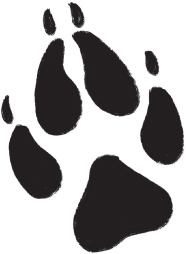
2
A Brief History of the Fox
WE ARE REDESIGNING THE FOX: its diet, territory size, social interactions, and its longevity and causes of death have all been changed by us. Even their body fats are impregnated with our lifestyle, carrying residues as diverse as fire retardants and nuclear radiation. Their days are filled with human-made noises, human-made landscapes, and human-made risks.
But foxes have not spent their evolutionary history sunbathing on greenhouse roofs or evading aggressive pet cats, let alone treading on broken glass or eating leftover pizza. Wild nature has been twisted out of joint in Britain; except for the lonely saltmarshes of the north Norfolk coast, very little has not been reshaped by our fingerprints. But to understand the fox among us, we must first consider the world as it was before.
I AM FOLLOWING a wild wolf with a hind foot as wide as my hand. The paw print is written in the soft clay of a path flanked by wrinkled old trees that take circuitous routes to the sky, their branches bending under a red squirrel’s leaps, their bark festooned with furry moss. Looking past their trunks, I see more trees, and yet more: shadows of green upon green, and woodpeckers laugh from within. There is not a sound nor sight save of natural things – just tree frogs purring at dusk, and pure, sweet, forest air. Where the canopy has been opened by a giant’s fall, new saplings race to the light over the carpet of wild garlic flowers. Deer consume many such infant trees and are themselves taken by wolves; the leftover bones fall to foxes.
This is Białowieża, lowland Europe’s closest match to a truly wild forest. It mantles the border of Poland and Belarus – a living palace of oak and hornbeam, and a mortuary of naturally dead trees that sport brilliantly coloured fungi, nourishing new life where they crumble. Old growth or primeval forests are relatively widespread in North America, although their fate is the subject of bitter battles between loggers and environmentalists. On the European Plain, we only have Białowieża, and its history has been uneven, from bison-hunting Russian Tsars to the Nazis who murdered Polish patriots under gently shadowing leaves.
Yet today, the rails laid by Germans to export timber in World War I are overgrown by wild pansies and chickweed. Disputes over logging in the buffer zone aside, the forest remains largely in control of itself, as it has been for most of the last 8,000 years. Human tragedies, triumphs and the entire Roman Empire have risen and fallen, and, all the while, Białowieża has quietly evolved along its own lines, its vast compendium of living things predating, competing, and joining into symbiotic relationships with each other. It is the last benchmark: a reference point that explains how European foxes are when the human touch is light.
That path where I found sign of the wolf’s wandering is also a datasheet of information. The damp ground reveals more tracks – of wild boar, roe deer, red deer, bison – and here, not three metres from the wolf’s trail, a fox footprint.
I could probably fit all four of its little paws into the track of its distant relation.
It is living here as a pure wild animal, sustaining itself on other life supported by the forest, and when it dies, its flesh will grow more trees.
What is a fox in such a place? I’ve caught glimpses on my camera traps: visually indistinguishable from foxes in gritty south London boroughs, they trot confidently down trails trampled by gargantuan bison bulls. They balance deftly on fallen tree trunks beside rivers that flood when they please. They lope across tracks at night, under crystalline stars untainted by light pollution.
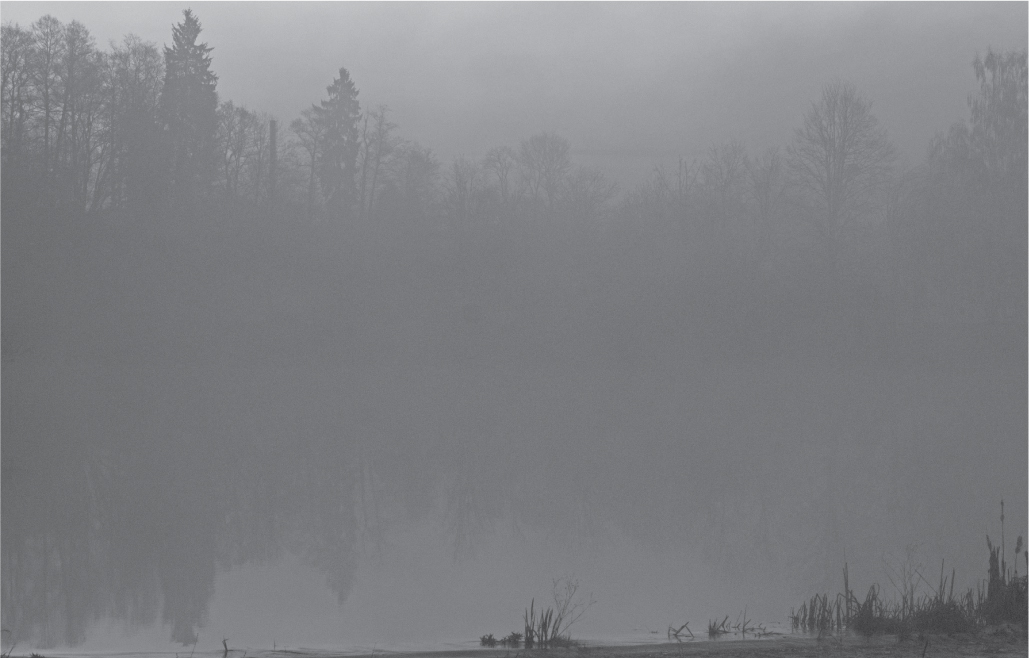
Białowieża
There are questions that all wildlife biologists ask of their study species, and most of them would take a lifetime of research to answer. Where do they live, and how are they distributed within those areas? Do the regions with the highest activity have characteristics in common? What about their social interactions with their own kind – do they defend territories? When do they breed, and how far do the young disperse? In a forest with uncountable forms of life, with which of the plants, mammals, birds, reptiles, and invertebrates do they interact as predator, as prey, as disperser of seeds, as bringer of change through some- thing as subtle as digging the mud to create a den?
Unravelling these mysteries requires deciding a research hypothesis, collecting data to test that hypothesis, and exploring those data with statistics or maps. I have no recourse for such ventures during my holidays in Białowieża. But I do spy some clues: fox scat, for example, the ubiquitous silent witness to their diet.
It is full of the bristling black hairs of wild boar.
Boar are as far beyond a fox’s hunting prowess as is an elephant – fourteen times heavier, and armed with tusks and teeth. They are quite capable of fending off leopards. Yet here in a near-pristine forest, they comprise a startling portion of vulpine diets.
The link is the wolf. About 30 per cent of the fox’s winter diet in Białowieża is carrion, specifically red deer and wild boar. Some may have starved, but many were killed by wolves and lynx. Despite the popular image of wolves as marauding Vikings, they inadvertently assist many other creatures. Ravens, martens and eagles are among those which feast on the wolf’s leftovers.
The beauty of this forest is its completeness; nothing is wasted, and ecological relationships almost forgotten in Britain’s radically altered landscapes shine clear.
Perhaps the message from Białowieża, then, is that the wild fox is an interactive creature. They are part of a living web that cycles energy from plants to herbivores to predators to scavengers, a natural dodgems in which species knock into each other. Sometimes that brings death to one and food to another; sometimes there is mutual gain. Wherever it is, whatever the backdrop, a fox can never be understood outside of its relationship with the rest of the natural world.
But what is a fox in the first place?
A FOX’S SKULL, like a wolf’s footprint, fits neatly in my hand. In its way, it is a birth certificate, a genealogical signpost that reveals the fox’s relationship to other mammals, living and extinct. Not for nothing did Victorian scientists spend so many hours measuring bones; patterns emerge from meticulous study, and the bewildering array of vertebrate life can be organised into logical groups. In recent decades, genetic analysis has refined our understanding.
So imagine an Ark with all the world’s animals entering two by two: birds, reptiles, amphibians, and other, more exotic creatures. A fox would enter the deck reserved for mammals, for it has fur and suckles its young, along with a diaphragm and a neocortex. But a fox is clearly different from its mammalian relatives. It is certainly not a bat, giraffe or horse. To divide mammals logically, Noah must look at their jaws. Teeth are not only clues to diet, but also indicate who is related to whom.
Foxes have 42 teeth inside their narrow muzzles, among them the trademark of the order Carnivora. Their last upper pre-molar and first lower molar are called carnassials, modified with a tall shearing edge for slicing flesh. All 300 or so Carnivorans possess carnassials. Your pet cat has them – in fact they are exceptionally well developed in felids, which are the most meat-specialised of the entire order. Pandas, on the other hand, have flattened carnassials because they are largely vegetarian.
What about foxes? Their carnassials are specialised for nothing. Berries, mice, insect larvae – they can eat it all. That adaptability is the main reason why the wild dog family has been such a runaway evolutionary success.
Foxes are of the canine kind. Many fox-watchers, including myself, enjoy the cat-like grace of the species: the delicate pounce and careful footsteps. But beneath that rich orange fur, foxes are undeniably a canid – that is, a member of Canidae, the dog family. Turning the skull over, the base of the ear sockets is fused into a bony casing called a tympanic bulla, protecting the fragile inner-ear bones. In canids it is uniquely divided by a septum: a thin, bony wall. It is believed that this extra echo-chamber enhances their ability to hear low frequencies.
Five toes with claws that are not fully retractile, a long muzzle filled with delicate turbinal bones that magnify smells, the nuchal ligament that strengthens their necks to allow them to run for extended periods with nose to the ground – the physical hallmarks are unambiguous. The fox is a dog.
Or very nearly.
THERE WAS ONCE another forest, more remote to our lives and fainter than Białowieża’s leathery trunks: an ancient jungle that no human saw, in a global climate hotter than we have ever known. Fifty million years ago, the so-called Eocene hothouse featured Earth at its balmiest, basking in temperatures averaging 14 °C (57 °F) higher than present. Ice vanished from even the poles, and lush forests extended across the globe. Palm trees grew in what is now the London basin; extinct primates foraged under them, and the peculiar horse-like ungulate Hyracotherium browsed in their shadows – but there were no foxes. Canids had not yet left their family cradle.





